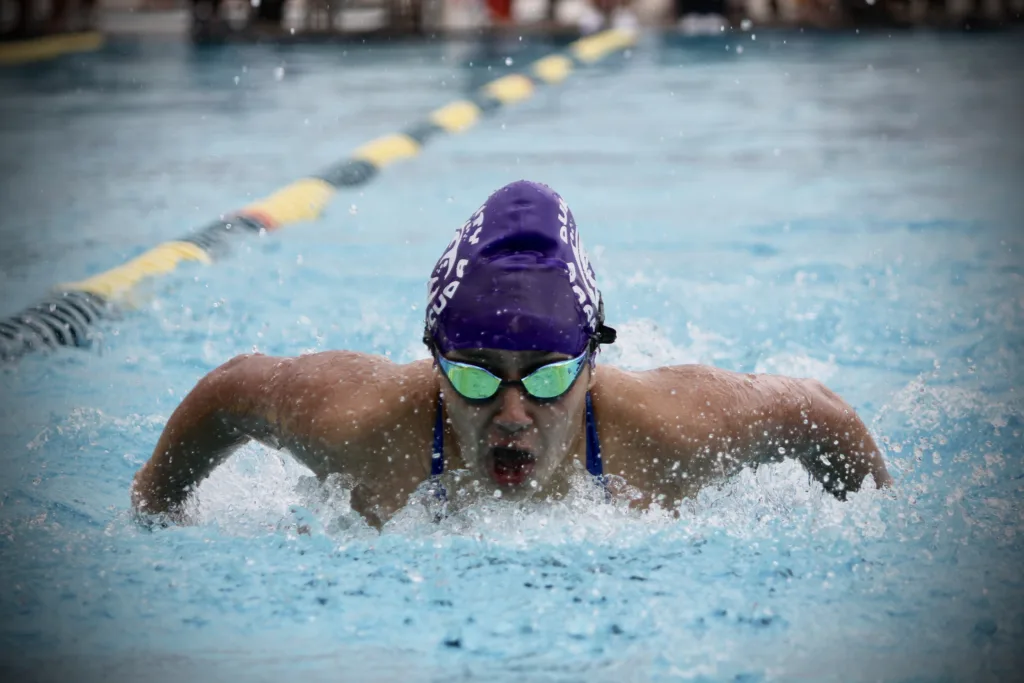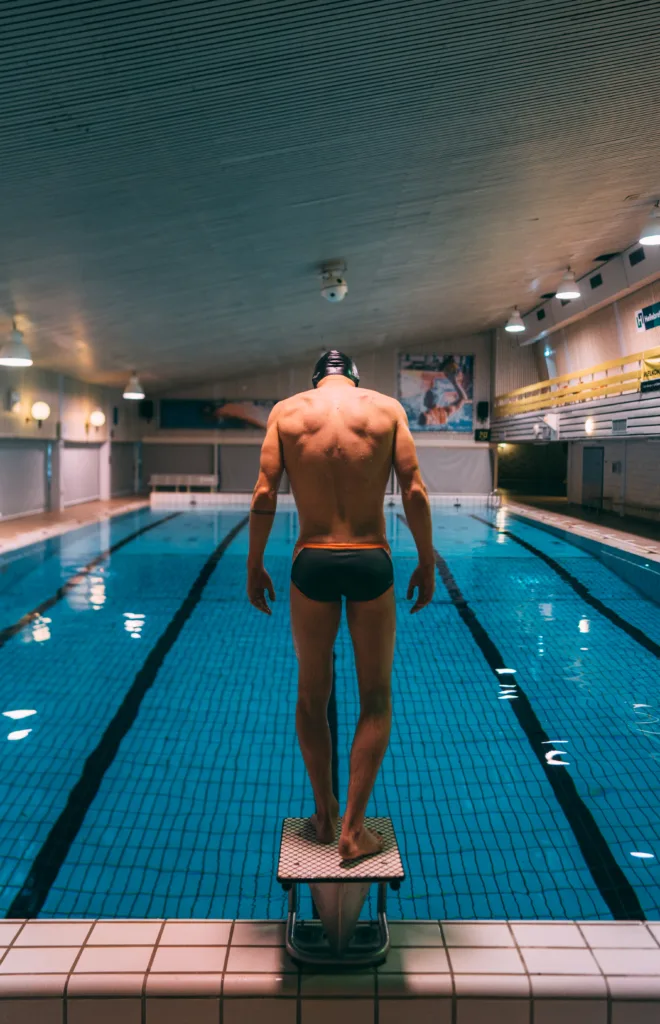Swimming is a popular sport that requires a lot of hard work, dedication, and perseverance. Swimmers are known for their lean, toned and muscular bodies, which are the result of years of training and a healthy lifestyle. In this article, we will explore the anatomy and physiology of a swimmer’s body, how they achieve their physique, and how you can too!
Swimming is a full-body workout that engages all major muscle groups, including the arms, shoulders, back, core, and legs. Swimmers’ bodies are characterized by broad shoulders, a defined core, toned legs, and a low body fat percentage. The repeated motion of pulling and kicking in the water helps to develop strong upper body muscles, such as the latissimus dorsi (lats), trapezius, and deltoids. This results in a broad and defined upper body that is ideal for swimming.
In addition to upper body strength, swimmers also need strong leg muscles to propel themselves through the water. The quadriceps, hamstrings, and calves are all heavily utilized during swimming, resulting in toned and defined leg muscles. The core muscles, including the abs and lower back, are also engaged in every stroke, helping to maintain proper form and stability in the water.
Swimmers achieve their lean and toned physique through a combination of swimming, strength training, and a healthy diet. Swimming is the main component of a swimmer’s training regimen, and they spend hours in the pool each week building endurance and honing their technique. Strength training is also essential for swimmers, with a focus on exercises that target the upper body, legs, and core muscles.
Swimmers also follow a healthy diet that is high in protein and low in fat and carbohydrates. Protein is essential for muscle growth and repair, and swimmers need to consume enough to support their rigorous training schedule. Carbohydrates are necessary for energy, but swimmers typically consume them in moderation to avoid excess body fat. Healthy fats, such as those found in nuts and fish, are also important for overall health and well-being.
If you’re interested in achieving a swimmer’s body, the first step is to start swimming! Regular swimming sessions will help you build endurance, improve your technique, and develop strong muscles throughout your body. It’s also important to incorporate strength training exercises into your routine, with a focus on upper body, leg, and core exercises.
In addition to exercise, a healthy diet is essential for achieving a swimmer’s body. Focus on consuming a balanced diet that is high in protein, low in fat and carbohydrates, and includes plenty of fruits and vegetables. Avoid processed foods, sugary drinks, and excessive amounts of alcohol.
A swimmer’s body is the result of years of hard work and dedication to swimming, strength training, and a healthy lifestyle. If you’re interested in achieving a swimmer’s physique, start by incorporating swimming and strength training into your routine and follwing a healthy diet. With time and effort, you too can achieve a lean, toned, and muscular body like a swimmer!
What Is A Swimmers Body Type?
A swimmer’s body type is characterized by a toned physique with well-defined muscles. It is typically lean and athletic, without excessive bulk. The regular swimming workouts help swimmers develop broad shoulders, strong triceps, and lats. These muscles are essential for the movement of the arms during swimming strokes. Swimmers also tend to have defined abs due to the core engagement required to maintain proper body alignment in the water. a swimmer’s body type is one that is built for efficient movement in the water, with toned muscles and a lean physique.

Why Do Swimmers Have Good Bodies?
Swimmers have good bodies for several reasons. Firstly, swimming is a highly effective full-body workout that engages multiple muscle groups simultaneously. The constant resistance of the water provides a challenging workout that helps build lean muscle mass and improve overall strength and endurance.
Additionally, swimming is a low-impact exercise, whih means it places less stress on the joints compared to other high-impact activities like running or weightlifting. This allows swimmers to train more frequently and for longer durations without risking injury or overtraining.
Moreover, swimmers usually follow a strict nutrition plan that supports their training goals. A balanced diet that includes lean proteins, complex carbohydrates, and healthy fats helps fuel their workouts and aids in muscle recovery.
Swimmers prioritize rest and recovery as an essential part of their training routine. Proper rest allows the body to repair and rebuild muscles, which leads to better performance and a more toned physique.
The combination of a full-body workout, low-impact exercise, a balanced diet, and adequate rest and recovery are the reasons why swimmers have good bodies.
How Swimmers Get Their Bodies?
Swimmers get their bodies by doing a lot of swimming, which is a great form of cardiovascular exercise that can help burn calories and build muscle. Swimming is particularly effective for toning the upper body, as it requires the use of the lats and shoulders to power through the water. Swimmers also tend to have strong quadriceps, as they use their legs to kick and propel thmselves forward.
In addition to swimming, strength training workouts can be helpful for achieving a swimmer’s body. These workouts should focus on the same muscle groups used in swimming, such as the lats, shoulders, and quadriceps. Resistance exercises like pull-ups, push-ups, and lunges can be effective for building strength and muscle in these areas.
To support their workouts, swimmers should follow a healthy diet that is low in carbohydrates, high in protein, and moderate in healthy fats. This can help to fuel their workouts and support muscle growth, while also helping to maintain a healthy weight. Additionally, it is important for swimmers to stay hydrated and get enough rest to allow their bodies to recover and repair after workouts.
Do Swimmers Have The Best Body?
Swimmers are known to have a unique body type that is often referred to as a “swimmer’s build.” This type of build is characterized by a low amount of body fat, resulting in a flat belly, defined back, and narrow waist. Swimmers tend to have a more muscular bulk compared to runners, who are typically leaner and lighter.
However, it is important to note that the concept of a “best body” is subjective and varies from person to person. Different sports and activities require different body types and physical attributes. While a swimmer’s build may be ideal for swimming, it may not necessarily be the best for other sports or activities.
Moreover, it is crucial to focus on overll health and fitness rather than just physical appearance. A healthy body is one that is well-nourished, physically active, and has a balanced body composition. Ultimately, the “best body” is one that is strong, healthy, and able to perform the activities and tasks needed in daily life.

Conclusion
A swimmer’s body is a result of dedicated training, proper nutrition, and recovery. Swimmers typically have a toned physique with broad shoulders, defined abs, lats, and triceps. Their body composition teds to be low in body fat, resulting in a lean, muscular build. To achieve a swimmer’s body, it is important to focus on swimming as the primary form of exercise, supplemented with strength training workouts to target specific muscle groups. A diet rich in protein and healthy fats while limiting carbohydrates can also aid in achieving a swimmer’s body. a swimmer’s body represents the hard work and dedication put into the sport of swimming.
